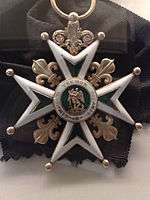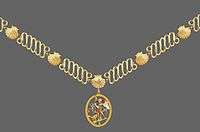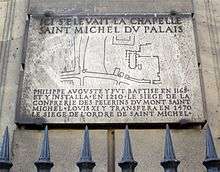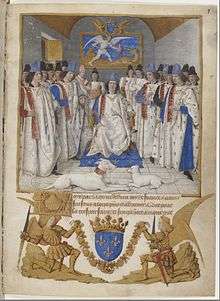Order of Saint Michael
| Order of Saint Michael Ordre de Saint-Michel | |
|---|---|
 | |
| Badge | |
| Award of The Kingdom of France | |
| Type | Military Order[1] |
| Royal house | Valois, Valois-Orléans, Valois-Orléans-Angoulême, Bourbon, Bourbon-Orléans[2] |
| Religious affiliation | Roman Catholic |
| Ribbon | |
| Status | Obsolete[2]/Defunct[1]/Abolished[2][3] |
| Established | 1 August 1469.[4] Abolished by decree of King Louis XVI on 20 June 1790.[5] Revived by King Louis XVIII on 16 November 1816[2] but abolished again in 1830.[3] The last knight died in 1850.[2] |
 | |
| Collar | |



.svg.png)
The Order of Saint Michael (French: Ordre de Saint-Michel) was a French chivalric order, founded by Louis XI of France on 1 August 1469,[4][6] in competitive response to the Burgundian Order of the Golden Fleece founded by Philip the Good, duke of Burgundy, Louis' chief competitor for the allegiance of the great houses of France, the Dukes of Orléans, Berry, and Brittany.[1] As a chivalric order, its goal was to confirm the loyalty of its knights to the king. Originally, there were a limited number of knights, at first thirty-one, then increased to thirty-six including the king. An office of Provost was established in 1476. The Order of St Michael was the highest Order in France until it was superseded by the Order of the Holy Spirit.[2]
As would be expected, the first knights were among the most powerful nobles in France, close relatives of the king and a few from other royal houses in Europe. Originally, the number of members (called companions) was limited to thirty-five.[1] In 1565, during the Wars of Religion, when loyalties were strained and essential, Charles IX increased the membership to fifty but there may have been as many as seven hundred knights under Henry III in 1574.[2]
The Order of St. Michael dedicated to the Archangel Michael conveyed to every member a gold badge of the image of the saint standing on a rock (Mont Saint-Michel) in combat with the serpent.[2] The motto the order was "immensi tremor oceani" (meaning the tremor of the immense ocean) derived from the idea of Saint Michael looking out over the Atlantic from Mont Saint-Michel.[7] It was suspended from an elaborate gold collar made of scallop shells (the badge of pilgrim, especially those to Santiago de Compostela) linked with double knots. The statutes state that the badge could be hung on a simple chain, and later it was suspended from a black ribbon.
When the Order of St Michael was founded, the famous illuminator Jean Fouquet was commissioned to paint the title miniature of the Statutes, showing the king presiding over the knights (Paris, Bibliothèque Nationale, fr. 19819).[8] The original plan was for the knights to meet yearly on 29 September at Mont Saint-Michel in Normandy.[9] Such an isolated location was impractical causing Charles VIII to transfer this meeting place to the chapel of Saint-Michel-du-Palais,[1] part of Paris' medieval royal residence the Palais de la Cité which the kings no longer used, to the control of the order in 1496.[2] By letters patent dated 15 August 1555, the seat of the Order was transferred to the royal Château de Vincennes outside Paris.[1]
The Order of St. Michael was abolished by Louis XVI on 20 June 1790.[5] It was revived by Louis XVIII on 16 November 1816[2] but the king took little interest in the order and no new knights were added after 1816. The Order was again abolished by the French authorities in 1830.[10] The Order's last member died in 1850.[2]
However, as is mentioned by French Government, it would be considered as the origin of the Ordre des Arts et des Lettres: "Saint-Michel Order (1460–1830) can be considered as the precursor of the Order of the Arts and Lettres. Originally destined to the aristocracy, from 17th to 18th Centuries it became an order of civil merit, which distinguished many artists, architects, collectors, and people of lettres…".[11], [12][13]
Notable Recipients
No formal list of members of the order exists.[1] The names of members can be gleaned from reference to their receipt of the order, from secondary sources, or from periodic lists compiled showing companions from particular families or regions.[1][14]
- Cesare Borgia, in 1499 by Louis XII[15]
- Francesco II Gonzaga, Marquess of Mantua in 1507 by Louis XII[16]
- Thomas Howard, 3rd Duke of Norfolk, in 1532 by Francis I[17]
- James V of Scotland, in 1534 by Francis I[18]
- Archibald Douglas, 6th Earl of Angus in 1545 by Francis I
- James Hamilton, Duke of Châtellerault in 1548 by Henry II
- George Gordon, 4th Earl of Huntly in 1548 by Henry II
- Archibald Campbell, 5th Earl of Argyll in 1548 by Henry II
- Paul de Thermes in 1549 for the capture of Haddington and Broughty Castle
- André de Montalembert in 1549 for the capture of Inchkeith[14]
- Edward VI of England, 1551 by Henry II[19]
- Henry Stewart, Lord Darnley under the name King Henry of Scotland, 1565 by Charles IX[20]
- Robert Dudley, 1st Earl of Leicester, 1566 by Charles IX[21]
- Thomas Howard, 4th Duke of Norfolk, 1566 by Charles IX[21]
- Michiel de Ruyter, in 1666 by Louis XIV.[22]
- François Caron, in 1672 by Louis XIV.[23]
- Constance Phaulkon, in 1687 by Louis XIV.[24]
Notes
- 1 2 3 4 5 6 7 8 Boulton, D'Arcy Jonathan Dacre (1986). The knights of the crown : the monarchical orders of knighthood in later medieval Europe, 1325-1520 (Paperback ed.). Woodbridge, Suffolk: Boydell Press. pp. 427–47. ISBN 978-0-85115-417-6.
- 1 2 3 4 5 6 7 8 9 10 11 Gout, Paul (1910). Le Mont-Saint Michel (in French). Paris: A. Colin. pp. 553–60.
- 1 2 Duckers, Peter (2008). European orders and decorations to 1945. Botley, Oxford, UK: Shire Publications. pp. 31–32. ISBN 978-0-7478-0670-7.
- 1 2 Meader, John R (1904). Beach, Frederick Converse; Rines, George Edwin, eds. "Orders (Royal) and Decorations of Honor". Encyclopedia Americana, Volume 11. The Americana company.
the Order of Saint Michael, founded 1 August 1469 by King Louis XI
- 1 2 Pinoteau, Benoit de Fauconpret ; préface d'Hervé (2007). Les chevaliers de Saint-Michel, 1665–1790 : le premier ordre de mérite civil (1ère éd. ed.). Paris: P. du Puy. ISBN 978-2-908003-35-2.
- ↑ Vachaudez, Christophe, Walgrave, Jan (2008). Diana Scarisbrick, ed. Royal jewels : from Charlemagne to the Romanovs. New York: Vendôme Press. p. 146. ISBN 978-0-86565-193-7.
Louis XI founded the Order of Saint Michael in 1469. Initially, there were thirty-six knights, but their numbers increased to such a point that the order began to lose its prestige. Louis XIV reformed the order on 12 January 1665, reducing the number of knights to one hundred
- ↑ Adams, Henry (2010). Mont-Saint-Michel and Chartres. [S.l.]: Read a Classic. p. 9. ISBN 978-1-61104-147-7.
- ↑ Duchhard, Heinz, Richard A. Jackson, David J. Sturdy (eds.) (1992). European monarchy : its evolution and practice from Roman antiquity to modern times. Stuttgart: Steiner. pp. 86–90. ISBN 978-3-515-06233-6.
- ↑ Contamine, Philippe (1978). L'ordre de Saint-Michel au temps de Louis XI et Charles VIII. Paris: La Société nationale des antiquaires de France. pp. 217–20.
- ↑ Martens, Karl von and Ferdinand de Wegman (1851). Le guide diplomatique: Précis des droits et des fonctions des agents diplomatiques et consulaires; suivi d'un traité des actes et offices divers qui sont du ressort de la diplomatie, accompagné de pièce et documents proposés comme exemples, Volume 1. Leipzig, Germany: F.A. Brockhaus. p. 154.
- ↑ Culture-Acte2 Archived 28 May 2012 at the Wayback Machine.
- ↑ Archives de France,
- ↑ Mémodoc
- 1 2 D'Hozier, Jean-François-Louis and Paul de Chabot (1895). Carné, edited by Gaston Louis Michel Marie, ed. "Les Chevaliers de Saint-Michel de La Province du Poitou depuis La Fondation de L'Ordre en 1469 Jusqu'a L'Ordannance de 1669". Revue historique de l'Ouest, Volume 11: 372–78.
On le trouve nommé, en 1549, dans un compte du trésorier de l Ordre de Saint Michel, où il est dit qu il fut délivré à messire André de Montalembert sgr d Essé, chev de l Ordre, le grand collier de l'Ordre de Saint Michel du feu comte de Languillare, dont le Roy avait fait don au dit sgr d'Essé, en le faisant et créant chevalier de son Ordre, ainsi qu'il apparaissait par son récépissé du 27 septembre de cette année
- ↑ Bradford, Sarah (1976). Cesare Borgia: His Life and Times. Great Britain: Phoenix Press. p. 101. ISBN 1-84212-452-8.
- ↑ Cartwright, Julia (1905). Isabella d'Este: Marchioness of Mantua 1474-1539 a Study of the Renaissance - Vol. 1. New York: E.P. Dutton. p. 295.
- ↑ Graves, Michael A.R. (2008). Thomas Howard, third Duke of Norfolk (1473–1554). Oxford Dictionary of National Biography.
- ↑ Cameron, Jamie (1998). James V: The Personal Rule, 1528–1542. The Stewart Dynasty in Scotland. East Linton: Tuckwell Press. p. 121. ISBN 1-86232-015-2.
- ↑ Beer, B.L. (1973): Northumberland: The Political Career of John Dudley, Earl of Warwick and Duke of Northumberland The Kent State University Press p. 114 ISBN 0-87338-140-8
- ↑ Anderson, Duncan (1849). History of the Abbey and Palace of Holyrood. Edinburgh, Scotland: Keeper of the Chapel Royal. p. 58. Archived from the original on 2011-12-15. Retrieved 2011-12-15.
about the beginning of February 1565-6, the Seigneur de Rembouillet, with a deputation from the King of France, arrived at the Palace, to present Darnley with the order of St. Michael, known as the Scallop or Cockle-shell Order, so called from the scallop shells of which the collar was composed. The investiture was performed after the celebration of mass in the Chapel-Royal
- 1 2 Hearn, Karen (1995). Dynasties: Painting in Tudor and Jacobean England 1530–1630. Rizzoli. p. 96. ISBN 0-8478-1940-X.
- ↑ Hellinga, Gerben Graddesz. (2007). Geschiedenis van Nederland: De Canon van ons Vaderlands Verleden. Zutphen: Walburg Pers. p. 83. ISBN 978-9057306006.
- ↑ Frazer, Robert Watson. (1896). British India, p. 42.
- ↑ Van der Cruysse, Dirk: Louis XIV et le Siam, Fayard, Paris 1991, p. 405. Cangelaris, P.D.: History and Genealogy of the Cangelari Family of Cephalonia (16th-20th Centuries), Corfu 2011, p. 91. (in Greek) ISBN 978-960-85532-2-4 Cangelaris, Panayotis D.: The French coat of arms of prime counsellor Costantin Gerachi (Constance Phaulkon), Athens 2013, p. 36-38. (reprint in Greek)
| Wikimedia Commons has media related to Order of St Michael. |
